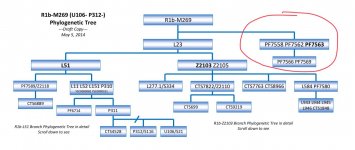maratmilano
Regular Member
- Messages
- 13
- Reaction score
- 4
- Points
- 0
- Location
- Seattle, WA
- Ethnic group
- 1/2 Armenian, 1/2 Azerbaijani
- Y-DNA haplogroup
- R1b L150+/PF6274
- mtDNA haplogroup
- U1
Hello. As an amateur enthusiast in the topic, there is a bit I have inferred on my own but I am still relatively new to ancestry genetics and certainly know less than many on here. I have the results from several different resources, and understandably they don't all say the same exact thing but I was curious if anyone could give me insight into any common patterns they see throughout them.
Background: I'm half Armenian, half Azerbaijani. I was born in Baku but my Armenian side descends from Karabakh (near Lachin) and further back in Julfa by Naxichevan. My Azeri side I know less about but my grandparents on that side came from Agjebedy (also near Karabakh) and Shemakhy.
My results...
Y-DNA - R1b1a1a2 (r-m269) though I'm told I'm L150+ L23- (and I'm not totally positive what this means)
mtDNA - U1
AncestryDNA:
70% Caucasus/West Asia
19% Europe South
7% Middle East
3% South Asia
MyHeritage:
83% West Asia
10% Italian
6% Greek
1% Middle East
FamilyTreeDNA:
93% Asia Minor
4% South Asia
2% Northeast Asia
1% West and Central Europe
WeGene:
European 50% (45%Balkan+4%Ashkenazi+1%French)
South Asia 23% (all 23% as 'Sindhi')
Middle Eastern 26% (13%Iranian+9%Egyptian+4%Saudi)
gedmatch kit#A606695 (if any of you know better tests to run I'd be happy to try)
Dodecad K7b:
48.4% West Asia
29% Southern
15.6% Atlantic Baltic
3.6% South Asian
1.5% Siberia.
1.3% East Asian
Dodecad K12b:
45.5% Caucasus
19.5% Gedrosia
12% SW_Asia
9% North European
8.5% Atlantic_Med
3% South Asia
1.7 East Asian
1.3 Siberian
Eurogenes K13:
37.5% West Asia
30% East Med
7.6% East Euro
5.7% South Asian
5% Atlantic
4.6% Red Sea
4.3% West Med
3% Baltic
1% Siberian
The GEDmatch tests have been interesting, though clearly different results show up differently in different tests, and different regions are defined in varying ways. This is where I'm getting a bit confused. Amazingly, the Oracle predictor has been fairly spot-on, as 'Armenia' and 'Azerbaijan' have shown up near the top of almost every test's predictions, and neighboring people's such as 'Turk' and 'Kurd' also frequently pop up for me.
What do you guys see when you look at my results? I'm aware that these can never tell the full exact story, but can any educated guesses be made at least? Why do the gedmatch tests show more Northern and Western influences like Atlantic_Med or Baltic while AncestryDNA and the like don't show much for me past the Greek/Italian.
Also, I'd appreciate if any fellow Armenians or Azeris as well as Turks, Iranians, Caucasus folk on here to check in and share how similar our results may be. I wish my family history were better documented beyond the 1800's, so I'd love from anyone who knows about the ethnic/migration history of the South Caucasus (particularly Karabakh and Naxichevan). Thanks!
Background: I'm half Armenian, half Azerbaijani. I was born in Baku but my Armenian side descends from Karabakh (near Lachin) and further back in Julfa by Naxichevan. My Azeri side I know less about but my grandparents on that side came from Agjebedy (also near Karabakh) and Shemakhy.
My results...
Y-DNA - R1b1a1a2 (r-m269) though I'm told I'm L150+ L23- (and I'm not totally positive what this means)
mtDNA - U1
AncestryDNA:
70% Caucasus/West Asia
19% Europe South
7% Middle East
3% South Asia
MyHeritage:
83% West Asia
10% Italian
6% Greek
1% Middle East
FamilyTreeDNA:
93% Asia Minor
4% South Asia
2% Northeast Asia
1% West and Central Europe
WeGene:
European 50% (45%Balkan+4%Ashkenazi+1%French)
South Asia 23% (all 23% as 'Sindhi')
Middle Eastern 26% (13%Iranian+9%Egyptian+4%Saudi)
gedmatch kit#A606695 (if any of you know better tests to run I'd be happy to try)
Dodecad K7b:
48.4% West Asia
29% Southern
15.6% Atlantic Baltic
3.6% South Asian
1.5% Siberia.
1.3% East Asian
Dodecad K12b:
45.5% Caucasus
19.5% Gedrosia
12% SW_Asia
9% North European
8.5% Atlantic_Med
3% South Asia
1.7 East Asian
1.3 Siberian
Eurogenes K13:
37.5% West Asia
30% East Med
7.6% East Euro
5.7% South Asian
5% Atlantic
4.6% Red Sea
4.3% West Med
3% Baltic
1% Siberian
The GEDmatch tests have been interesting, though clearly different results show up differently in different tests, and different regions are defined in varying ways. This is where I'm getting a bit confused. Amazingly, the Oracle predictor has been fairly spot-on, as 'Armenia' and 'Azerbaijan' have shown up near the top of almost every test's predictions, and neighboring people's such as 'Turk' and 'Kurd' also frequently pop up for me.
What do you guys see when you look at my results? I'm aware that these can never tell the full exact story, but can any educated guesses be made at least? Why do the gedmatch tests show more Northern and Western influences like Atlantic_Med or Baltic while AncestryDNA and the like don't show much for me past the Greek/Italian.
Also, I'd appreciate if any fellow Armenians or Azeris as well as Turks, Iranians, Caucasus folk on here to check in and share how similar our results may be. I wish my family history were better documented beyond the 1800's, so I'd love from anyone who knows about the ethnic/migration history of the South Caucasus (particularly Karabakh and Naxichevan). Thanks!
Last edited:


